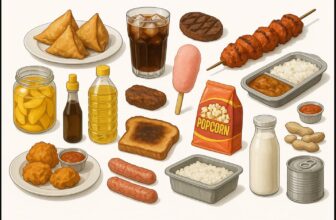India doesn’t need a war or a pandemic to throw your food supply off track. One flood, a few days of power outage, a transport strike, or sudden lockdown is enough to empty local stores and cut off deliveries. When fresh vegetables, milk, and daily essentials disappear from shelves, what’s in your home becomes your fallback.
That’s where long-term food planning matters, not just for preppers, but for families who want to stay fed, calm, and healthy when normal breaks down.
This isn’t about hoarding. It’s about keeping smart, shelf-stable, nutrient-dense foods that:
- Shelf life of 12+ months
- No refrigeration needed
- Minimal cooking or fuel requirement
- Safe to store in average Indian kitchen cabinets
This isn’t a doomsday list. It’s a practical buffer against floods, curfews, strikes, pandemics, or extended power cuts, times when access to fresh food breaks down.
The List: 25 Foods with 12+ Month Shelf Life
Each item includes shelf life range under Indian conditions and its specific survival value.
Choosing these foods isn’t just about how long they last, it’s about how often they’re used. All 25 are familiar to Indian kitchens, so you’re not storing obscure ingredients you won’t touch.
They also work well together. You can create balanced meals from this list alone, grains, protein, healthy fat, flavorings, hydration aids, all covered.
1. White Rice (Basmati or Parboiled)
- Shelf life: 24-36 months
- High-calorie base for meals, cooks easily, stores well if kept dry.
Most Indian households already store rice, but not always for long-term needs. Buying an extra 5-10 kg and sealing it airtight can cover weeks of disruption. Basmati for taste or parboiled for nutrition, both are equally good. Avoid brown rice for survival storage since its natural oils turn rancid faster.
2. Whole Millets (Ragi, Jowar, Bajra)
- Shelf life: 18-24 months (whole grain, not flour)
- Nutrient-rich, resilient to pests, easy to rotate with rice.
Millets are making a comeback for a reason. They’re gluten-free, require less water to grow, and can be stored longer than wheat flour or brown rice. In crisis scenarios, millets offer a more complete nutrient profile and better blood sugar control, useful if you’re relying heavily on stored foods.
3. Puffed Rice (Murmura)
- Shelf life: 12-15 months sealed
- Lightweight, no-cook snack or filler for dry bhel-type mixes.
It’s more than a snack. Add some roasted peanuts, jaggery, or spice mix and you have a quick, energy-dense, low-fuel meal. You can also use murmura as a dry cereal alternative when milk is limited. It holds up well in humid weather if kept sealed.
4. Poha (Flattened Rice)
- Shelf life: 12-15 months
- Quick to cook or soak; versatile across Indian cuisines.
Poha cooks in 5 minutes, needs no oil, and takes on whatever flavor you add, salt, chilli, peanuts, jaggery. Perfect for low-resource cooking. You can even make sweet poha with milk powder and raisins or use it dry-roasted as a snack. It’s one of the most flexible grains to store.
5. Toor, Moong, and Masoor Dal (Whole or Split, Unpolished)
- Shelf life: 12-18 months if dry and insect-free
- Reliable vegetarian protein, cooks fast under pressure.
These dals don’t just offer protein, they’re familiar, comforting, and form the heart of Indian home cooking. They’re easy to rotate into regular meals. Store in separate airtight jars to prevent cross-infestation and consider solar drying before sealing if your region has high humidity.
6. Roasted Chana (Vacuum Sealed)
- Shelf life: 12-15 months
- Protein-packed snack, no cooking needed.
Roasted chana is incredibly durable and can be eaten on its own or mixed into sattu. It’s shelf-stable even in summer if properly packed. A handful provides protein, fiber, and crunch, a better emergency snack than processed chips or biscuits.
7. Canned Rajma / Chana (Retort Pouch or Tin)
- Shelf life: 18-24 months unopened
- Fully cooked, ready to eat after heating, no prep required.
Canned legumes are underused in India but offer great value. You can eat them straight or mix with spices and rice for a full meal. In a crisis where water is scarce or gas is rationed, having a few tins of rajma can make all the difference.
8. Milk Powder (Full Cream or Skimmed)
- Shelf life: 18-24 months unopened
- Useful for tea, children, or baking during milk shortages.
Milk powder works for everything: chai, porridge, or just as a quick glass of milk. One pack goes a long way. Make sure to keep it sealed and dry, and store away from the stove or window. Opened packs must be used quickly.
9. Refined Sugar
- Shelf life: Indefinite if dry
- Energy, chai, preserves; also a morale booster in tough times.
Sugar isn’t essential for survival, but it keeps energy levels up and makes stored food more palatable. Use it to preserve fruit, make simple sweets, or just to sweeten a bland survival meal. Just keep it bone dry.
10. Jaggery (Gur)
- Shelf life: 12-18 months sealed
- Energy-dense, mineral-rich sweetener, safer than sugar in humid regions.
Jaggery doesn’t just sweeten. It adds iron, fights fatigue, and offers warmth in colder regions. Unlike sugar, it pairs well with dal, rotis, and cereals like ragi. Use paper wrapping or double seal to keep ants away.
11. Honey
- Shelf life: Indefinite
- Natural sweetener, antimicrobial, and excellent for wound care.
Honey is one of the few foods that never spoils if sealed properly. You can use it for tea, desserts, or even sore throats. It’s also great for emergency first aid as a topical wound treatment. Choose local honey with no additives.
12. Salt (Iodized or Rock Salt)
- Shelf life: Indefinite
- Essential mineral, no spoilage risk, useful for preserving other foods.
Salt is critical for hydration, cooking, and preserving food. It also deters microbial growth. In times of crisis, it may even be used to clean or dehydrate vegetables for storage.
13. Refined Cooking Oil (Sealed PET or Tin)
- Shelf life: 12 months unopened
- Needed for cooking; avoid local oils with short stability.
Sealed oils stay fresh for months but once opened must be used quickly. Keep small bottles sealed. Avoid groundnut or mustard oil for long-term storage as they spoil faster. Use refined sunflower or rice bran oil instead.
14. Ghee (Sealed Jar or Tin)
- Shelf life: 12-18 months unopened
- No refrigeration needed; adds fat and calories with a small amount.
Ghee adds flavor, richness, and shelf stability. Just a spoon can transform a plain dish. Traditional Indian kitchens store ghee without refrigeration. Stick to branded, sealed packs for longer storage.
15. Instant Coffee / Loose Tea (Sealed)
- Shelf life: 18-24 months unopened
- Keeps mental alertness high, especially in stressful conditions.
Having tea or coffee during power cuts or stress events helps boost morale. Store in tins or vacuum packs to prevent flavor loss. A warm drink is always welcome in a survival scenario.
16. ORS Sachets / Glucose Powder
- Shelf life: 2-3 years
- Life-saving during dehydration, fever, or extreme heat.
Dehydration is a real threat in Indian summers or viral illness. ORS is compact, light, and mixes with boiled or filtered water. Glucose powder also gives fast energy to sick or weak individuals. Store in sachets for easier dosing.
17. Oats (Rolled or Quick)
- Shelf life: 18-24 months sealed
- Fast-cook meal or porridge, pairs well with milk powder and jaggery.
Oats are global survival food, high fiber, low effort. You can make salty upma or sweet porridge. Look for vacuum-sealed oats that are whole, not instant, to extend shelf life.
18. Powdered Eggs (Optional, Non-Veg)
- Shelf life: 18-24 months
- Long-lasting protein backup for baking or mixing.
These are uncommon in India but increasingly available online. Use for high-protein meals during shortage. Rehydrate with water to use like beaten egg. Store in a cool, dry place.
19. Multivitamin Tablets
- Shelf life: 18-24 months
- Compensates for loss of fresh fruits and vegetables.
When fresh produce is unavailable, vitamins bridge nutrition gaps. Store tightly sealed in original containers. Include vitamin D and iron variants suited to Indian diets.
20. Whole Spices (Turmeric, Cumin, Clove, Cardamom)
- Shelf life: 24-36 months
- Long-lasting flavor, digestion support, antimicrobial properties.
Whole spices are much more shelf-stable than ground versions. Use sparingly to flavor bland foods or aid digestion during stress.
21. Bay Leaves / Neem Leaves
- Shelf life: 2 years
- Pest deterrent in rice/dal storage; bay leaves also flavor food.
Bay leaves and neem repel insects and help preserve pulses and grains. Keep in muslin cloth inside jars or bins. Replace every 6-9 months.
22. Dry Red Chillies (Whole)
- Shelf life: 18-24 months
- Adds heat, good for preservation; better than chilli powder for storage.
Whole chillies store better than powders. Add to tempering or soak and grind. Use in chutneys, dals, and dry mixes. Store airtight to prevent pest damage.
23. Popcorn Kernels (Whole Corn)
- Shelf life: 18-24 months
- Snackable, fun, no oil needed if air-popped.
Popcorn is a morale-boosting snack and needs only dry heat. Safe even for kids. Store in PET jars away from moisture.
24. Dry Soy Chunks / Nutri Nuggets
- Shelf life: 12-18 months
- Vegetarian protein, rehydrates quickly, doesn’t spoil in heat.
Soy nuggets are compact, easy to prepare, and high in protein. They last well even in extreme weather. Use in pulao, curries, or dry snacks.
25. Dry Instant Mix for Khichdi / Pongal
- Shelf life: 12-15 months if vacuum-sealed
- Complete meal with just water and low heat.
Homemade or store-bought, these mixes combine dal, rice, and spices. Perfect for single-meal preparation with minimal gas or time.
How to Store All This Without Special Equipment
- Use steel dabbas, PET jars, or mylar bags with oxygen absorbers
- Label every container with purchase and expiry dates
- Keep in a dry, dark, elevated space , avoid floor, stove, and sunlight
- Place neem leaves or bay leaves inside grain containers
- Buy in smaller units , 1 kg packs spoil slower than 5 kg sacks
You don’t need a bunker. You need consistency. A pantry with 20-25 shelf-stable items makes every future disruption easier to manage. Don’t rely on your memory. Label, rotate, and keep track. This is about readiness, not randomness.
Summary: Stock for the Future, But Eat What You Store
Long-term food storage in India isn’t just about preparing for floods, curfews, or blackouts. It’s about building quiet resilience, a pantry that supports you during sickness, job loss, travel disruptions, or just a bad monsoon season.
These 25 items are chosen not just because they last, but because they can be used in normal meals too. Rotate them. Cook with them occasionally. Teach your household how to prepare them.
Start small if needed. Even stocking just 10 of these items can get you through an unexpected two-week crisis. Over time, build it into a dependable system.





